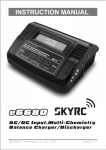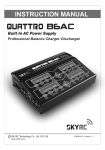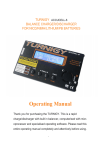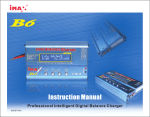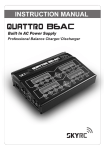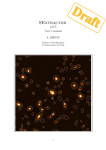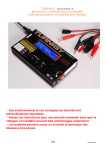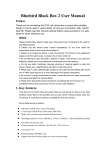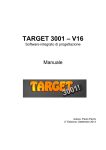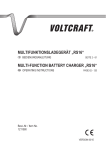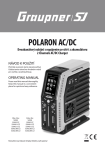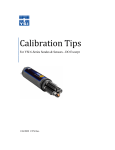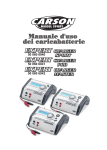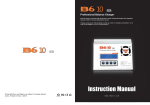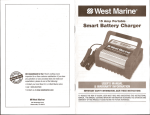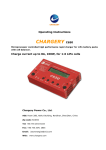Download Specifications Special features
Transcript
Thank you for purchasing the 680 Charger. You get a rapid charger/discharger with a built-in balance, which is computerized with a high performance microprocessor and specialized operating software. Please read this entire operating manual completely and attentively as it contains a wide variety of specific programming and safety information. Specifications Operating voltage range: Circuit power: DC 10.0—18.0 Volt max. 80W for charging max.10W for discharging Charge/Discharge current range:0.1—6.0A/0.1—2.0A Current drain for balancing Li-po: 300mAh/cell NiCd/NiMH battery cell count: 1—15Cells 1—6Series Lithium battery cell count: Pb battery voltage: 2 to 20V Special features Optimized operating software When charging or discharging, it has an “AUTO” function that sets the feeding current automatically. Especially for Lithium batteries, it can prevent the overcharging can lead to an explosion by users fault. Every program in the unit is controlled with mutual links and communication for every possible error so it introduces a maximum safety. These can be set at users option. Dual input power It employs the circuit that maximum output power of 50W for charging. As a result, it can charge up to 15 1 cells of NiCd/NiMH and 6 series of Lithium batteries with maximum current of 5A. But there might be the limit of feeding current to a higher voltage of battery. Please refer to “Maximum circuit power charge”. Individual voltage balancer for Lithium batteries inside It has an individual-cell-voltage balancer inside. So it does not need any balancer separately when charging Lithium batteries (Lilon/LiPo/LiFe) for cell voltage balancing. Balance individual cells on discharge It also can monitor and balance individual cells of the Lithium battery pack during the discharge process. If the voltage of any one cell varies abnormally, the process will be stopped with the error message. Accept various types of Lithium battery It can accept three types of Lithium batteries: Lilon, LiPo and LiFe. They have different characteristics by their chemistry. You can select any one of them that you are going to process before the job. For their specifications, refer to “Warnings and safety notes” section. Lithium battery “Fast” and “Storage” mode You can charge Lithium battery for special purposes. “Fast” charge reduces the charging time of Lithium battery and “Storage” mode controls the final voltage of the battery to be suit for long time storage. Maximum safety Delta-peak sensitivity: The automatic charge 2 termination program works on the principle of the Deltapeak voltage detection. (NiCd/NiMH) Auto-charge current limit: When charging NiCd or NiMH at “AUTO” current mode, you can set the upper limit of charge current to avoid from high current charging. This is very useful when charging the low impedance and small capacity NiMH battery in “AUTO” mode. Capacity limit: The charging capacity always calculated by multiple of the charging current and time. If the charging capacity exceeds the limit the process will be terminated automatically when you set the maximum value. Temperature limit: The temperature of the battery on charging will rise by its internal chemical reaction. If you set the limit of temperature the process will be expired forcibly when the limit has reached. Processing time limit: You can also restrain the maximum process time to prevent from any possible defect. Input power monitor: To protect the car battery using as DC input power from being damaged the voltage of it always monitored. If it drops below the lower limit the process will be ended automatically. Data store/load For users convenience it can store maximum 5 data of different batteries. You can establish the data contains program setting of the battery to charge or discharge continually. These data can be called out at any time you need and the process can be executed without program setting. 3 Cyclic charging/discharging Perform 1 to 5 cycles of charge> discharge or discharge> charge continually for battery refreshing and balancing. PC based analysis using USB communication For technical expert, it offers PC based program can analysis the characteristic of the battery by USB port. It shows a graph of voltage, current, capacity and temperature curves. It also shows the individual voltage of each cell in the Lithium battery pack. PC-LINK USB adaptor can be purchased separately. Warnings and safety notes Those warnings and safety notes are particularly important. Please follow the instructions for a maximum safety; otherwise the charger and the battery can be damaged violently. And also it can cause a fire to injure a human body or to lose the property. 1.Never leave the charger unsupervised when it is connected to its power supply. If any malfunction is observed immediately terminate the process and refer to the operation manual. 2.Keep away the charger from dust, damp, rain, heat direct sunshine and vibration. Do not drop it. 3.The circuit of this charger is designed to be powered by a 12V DC. But do not supply both input power simultaneously. The circuit can be damaged permanently. 4.This charger and battery to be charged and discharged should be set up on a head-resistant, noninflammable and non-conductive surface. Never place them on a car seat, carpet or similar. 4 5.Keep all the inflammable volatile materials well away from operation area. 6.Be sure to understand the information of the battery to be charged or discharged accurately. If the program is set up incorrectly the battery can severely be damaged. Especially Lithium battery can cause a fire or an explosion by over-charging. NiCd/NiMH voltage level: 1.2V/cell allowable fast charge current: 1C—2C depends on the performance of cell discharge voltage cut off level: 0.85V/ cell(NiCd), 1.0V/cell(NiMH) Lilo voltage level: 3.6V/cell max. charge voltage: 4.1V/cell allowable fast charge current : 1C or less min. discharge voltage cut off level: 2.5V/ cell or higher LiPo voltage level: 3.7V/cell max. charge voltage: 4.2V/cell allowable fast charge current : 1C or less min. discharge voltage cut off level: 3.0V/ cell or higher LiFe voltage level: 3.3V/cell max. charge voltage: 3.6V/cell allowable fast charge current : 4C or less (e.g.A123M1) min. discharge voltage cut off level: 2.0V/ cell or higher Pb voltage level: 2.0V/cell (Lead-acid) max. charge voltage: 2.4V/cell allowable fast charge current : 0.4C or 5 less min. discharge voltage cut off level: 1.75V/cell or higher 7.To avoid short-circuits between the charge lead, always connect the charge cable to the unit first and only then to the battery to be charged or discharged. Reverse the sequence when disconnection. 8.Do not connect more than one battery pack to charge at any one time. 9.Do not attempt to charge or discharge below types of battery: 1)Battery pack, which consists of different types of cell (including different manufacturers). 2)Battery, which is already fully charged or just slightly discharged. 3)Non-rechargeable batteries. (Explosion hazard) 4)Batteries that require a different charge technique from NiCd, NiMH, Lilon, LiPo, LiFe or Pb. 5)Faulty or damaged battery. 6)Battery fitted with an integral charge circuit or a protection circuit. 7)Batteries installed in a device, or which are electrically linked to other components. 8)Batteries that are not expressly stated by the manufacturer to be suitable for the currents the charger delivers during the charge process. 10.Please check below point before charge operation. 1)Select the appropriate program which is suitable for the type of battery. 2)Set up adequate current for charging or discharging. 3)Lithium battery pack can be composed with parallel 6 and series circuits mixed. You have to check the composition of the battery pack carefully before charging. 4)Be sure all the connections firm and safe, on intermittent contact at any point in the circuit. General notes on operating it. Charging A specific quantity of electrical energy is fed into the battery during charge process. The charge quantity is calculated by multiplying charge current by charge time. The maximum permissible charge current varies according to the battery type or its performance, and can be found in the information provided by the battery manufacturer. It is only allowed to charge batteries at rates higher than the standard charge current if they are expressly stated to be capable of quick-charge. Connect the battery to charge to output terminal of the charger using suitable charge lead. They are red, positive (+) and black, negative (-). Since the charger cannot detect the difference between the internal resistance of the battery pack, cable resistance and connector transfer resistance, the first requirement if the charger to work properly is that the charge lead should be of adequate conductor cross-section. And also highquality connectors (normally gold-contact type) must be fitted to both ends. Refer to the information provided by the battery manufacturer regarding charging methods, and verify the recommended charge current and charge time. Especially for Lithium batteries, you have to follow the charge instruction provided by the manufacturer strictly. Do not attempt to disassemble the battery pack 7 arbitrarily. You have to pay attention to verify the capacity and the voltage of the Lithium battery pack. It may be composed of parallel and series connection mixed. In parallel link the capacity of the battery pack is multiplied by the number of cells but the voltage remains same. That kind of voltage imbalance causes a fire or explosion during charge process. We recommend you compose the Lithium battery pack in series only. Discharging The typical purpose of discharge is to determine the residual capacity of the battery, or to lower the voltage of battery to a defined level. When you discharge the battery you also have to pay attention to the process same as charging. To avoid the battery becoming deepdischarged, set the final discharge voltage correctly. Lithium batteries should not be deep-discharged to lower than the minimum voltage, as this leads to a rapid loss of capacity or a total failure. Generally, you do not need to discharge Lithium battery voluntarily. Some rechargeable batteries are said to have a memory effect. If they are partly used and recharged before the whole charge is drawn out, they “remember” this and next time will only use that part of their capacity. This is a “member effect”. NiCd and NiMH batteries are said to suffer from memory effect. They prefer complete cycles; fully charge then use until empty, do not recharge before storage—allow them to self-discharge during storage. NiMH batteries have less memory effect than NiCd. The Lithium battery prefers a partial rather than a full 8 discharge. Frequent full discharges should be avoided if possible. Instead, charge the battery more often or use a larger battery. The brand-new NiCd battery pack is partially useful with its capacity until it has been subjected to 10 or more charge cycles in any case. The cyclic process of charge and discharge will lead to optimize the capacity of battery pack. 9 Program flow chart 10 Initial parameter set up (Users set up) It will be operated with the default value of the essential user settings when it is connected to a 12V battery or a AC wall socket for the first time. The screen displays the following information is sequence and the user can change the value of parameter on each screen. When you are willing to alter the parameter value in the program, press Start/Enter key to make it blink then change the value with INC/DEC key. The value will be stored by pressing Start/Enter key once. The screen displays the nominal voltage of Lithium LiFe battery. There are three V.Type 3.3V kinds of Lithium battery; Display LiFe(3.3V), Lilo(3.6V) or - + LiPo(3.7V). this is very DEC INC DEC INC important so you have to check the battery carefully and set it up correctly. If it is different from correct value the battery can explode during charge process. LiPo/Lilo/LiFe CHK Time 10min Display - + DEC INC DEC INC It recognise the cell count of Lithium battery automatically at the beginning of charge or discharge process to avoid from erroneous setting by user. But deeply discharged battery can be 11 perceived incorrectly. To prevent the error, you can set the time term to verify the cell count by the processor. Normally, 10 minutes are enough to perceive the cell count correctly. For the battery of larger capacity, you may extend the time term. But if you set the time term too long for the battery of smaller capacity, the charge or discharge process can be finished within the time term with the erroneous cell count. This may cause the fatal result. If the processor recognizes the cell count NiMH Sensitivity incorrectly at the beginning D.Peak Default of charge or discharge Display process, you may extend - + DEC INC the time. Otherwise, you DEC INC had better use with the default value. This shows the trigger voltage for automatic NiCd Sensitivity charge termination of D.Peak Default NiMH and NiCd battery. Display The effective value ranges - + DEC INC from 5 to 20mV per cell. If DEC INC the trigger voltage is set higher, there is a danger of overcharging the battery; if it is set lower, there is a possibility of premature termination. Please refer the technical specification of the battery. (NiCd default: 12mV, NiMH default: 7mV) You can select the function of 3-pin port at left side of 12 the unit.It can be used temperature sensor port or USB port selected at this screen.If the port is assigned as a temp. port,an optional temperature probe contacting the surface of battery can be used.When it is selected as an USB port ,you can link the charger to your PC via an optional USB cable. This can utilize the optional USB/Temp Select Temp Cut-Off 80C software that can show you the charge process at PC. Display - - + + DEC INC DEC INC USB/Temp Select Temp Cut-Off 80C - Display - + + DEC INC DEC INC DEC INC You can set the maximum temperature at which the charger should allow battery to reach during charge. Once a battery reaches this temperature during charge, the process will be terminated to protect the battery. The battery is on the cyclic process of charge and discharge can often Display become warm after charge + - + DEC INC DEC INC or discharge period. The DEC INC program can insert a time delay to occur after each charge and discharge process to allow the battery adequate time to cool down before being subjected to the next process. The value ranges from 1 to 60 minutes. Waste time CHG/DCHG 5min 13 When you start a charge process, the integral safety timer automatically starts running at the same time. This is programmed to prevent overcharge the battery if it Safety timer proves to be faulty, or if the ON 120min termination circuit cannot Display detect the battery full. - + - + DEC INC DEC INC Please refer the statement DEC INC in below to calculate the time setting. This program sets the maximum charge capacity Capacity Cut-Off that will be supplied to ON 5000mAh the battery during charge. Display If the delta-peak voltage - + - + DEC INC DEC INC is not detect ed nor the DEC INC safety timer expired by any reason, this feature will automatically stop the process at the selected capacity value. Key Beep Buzzer ON ON Display - + DEC INC DEC INC The beep sounds at every time pressing the buttons to confirm your action. The beep or melody sounded at various times during operation to alert different mode changes. These audible sounds can be on or off. 14 Input power Iow Cut - Off 10.0V Display - + DEC INC This program monitors the voltage of input DC battery. If the voltage drops below the value you set the operation forcibly terminated to protect the input battery. Lithium battery (Lilo/LiPo/Life) program These programs are only suitable for charging and discharging Lithium batteries with a nominal voltage of 3.3V, 3.6V and 3.7V per cell. These batteries need to adopt different charge technique is termed a constant voltage (CV) and constant current (CC) method. The charge current varies according to the battery capacity and performance. The final voltage of charge process is also very important; it should be precisely matched with the charade voltage of the battery. They are 4.2V for LiPo, 4.1V for Lilo, and 3.6V for LiFe. The charge current and nominal voltage as for cell count set on the charge program must always be correct for the battery to be charged. When you are willing to alter the parameter value in the program, press Start/Enter key to make it blink then change the value with INC or DEC key. The value will be stored by pressing Start/Enter key once. Charging Lithium battery The left side of the first line shows the type of battery you select at the users setting. The value on the left side of second line sets a charge current and the value on the right side of second line sets the voltage of the battery 15 LiPo 2.0A - + DEC INC Batt type Stop CHARGE 11.1V(3S) Display - + DEC INC Start '>3 seconds' Enter pack. After setting the current and voltage press Start/ Enter key for more than 3 seconds to start the process. (Charge current: 0.1— 5.0A, Voltage: 1—6 series) This shows the number of cells you set up and the processor detects. “R:” shows the number of cells found by the charger and “S:” is the number of cells selected by you at the previous screen. If both numbers are identical you can start charging by press Start/ R:3 SER S:3SER Enter button. If not, press CONFIRM(ENTER) Batt type/Stop button Display t o go back to previous Start screen. Then carefully Enter check the number of cells of the battery pack to charge again. Li3S 2.0A 12.59V CHG 022:43 00682 The screen shows the Display present situation during number charging battery charged charge process. To stop of time voltage capacity cells charging press Batt charge current type/Stop key once. Charging Lithium battery at balance mode This is for balancing the voltages of Lithium batteries 16 of the battery pack to be charged. To do this, the battery pack being charged should have the individual cell connector. And connect it to the individual port at the right side of charger with a suitable connection cable that fits with your battery pack. And also, you need to connect the battery output plug to the output of charger. In this mode, the charging process will be different from ordinary charging mode. The internal processor of the charger will monitor the voltages of each cell of the battery pack and controls the charging current that is feeding to each cell to normalize the voltage. The value on the left side of second line sets a charge current and the value on Display the right side of second - + - + DEC INC DEC INC line sets the voltage of the Batt type Start '>3 seconds' battery pack. Stop Enter After setting the current and voltage press Start/ Enter key for more than 3 seconds to start the process. LiPo BALANCE 2.0A 11.1V(3S) This shows the number of cells you set up and the processor detects. “R:” Display shows the number of cells Start found by the charger and Enter “S:” is the number of cells selected by you at the previous screen. If both numbers are identical you can start charging by press Start/Enter button. If not, R:3 SER S:3SER CONFIRM(ENTER) 17 press Batt type/Stop button to go back to previous screen. Then carefully check the number of cells of the battery pack to charge again. Li3S 2.0A 12.59V CHG 022:43 00682 Display number charging of time cells battery charged voltage capacity charge current The screen shows the present situation during charge process. To stop charging press Batt type/Stop key once. “FAST” charging Lithium battery The charging current is getting smaller as the process goes to the near end term of Lithium battery charging. To finish charging process earlier, this program eliminate certain term of CV process. Actually, the charging current will goes to 1/5 from the initial value to end the process while the normal charging goes to 1/10 during CV term. The charging capacity may be a bit smaller than normal charging but the process time will be reduced. LiPo FAST CHG 2.0A 11.1V(3S) - + DEC INC Batt type Stop Display - + DEC INC Start '>3 seconds' Enter Yo u c a n s e t u p t h e charging current and the voltage of the battery pack being charged. As you press Star t/ Enter button the voltage 18 confirmation will be displayed. And then, if you confirm the voltage and current, press Start/Enter button again to start charging. Li3S 2.0A 12.59V FAS 022:43 00682 This shows the present state of “FAST” charging. To stop charging arbitrary, press Batt type/Stop key once. Display number of cells elapsed time supplied Current capacity voltage of battery charge current “STORAGE” control Lithium battery This is for charging or discharging Lithium battery not to be used for the time being. The program will determine to charge or discharge the battery to the certain voltage depending on the voltage of the battery at its initial stage. They are different from the type of the battery, 3.75V for Lilo, 3.85V for LiPo and 3.3V for LiFe per cell. If the voltage of battery at its initial stage is over the voltage level to storage, the program will start to discharge. LiPo STORAGE 2.0A 11.1V(3S) - + DEC INC Batt type Stop Display - + DEC INC Start '>3 seconds' Enter You can set up the current and the voltage of the battery pack to be charged. The current will be used for charge or discharge the battery to reach the “storage” level of voltage. 19 The screen shows the present situation during charge process. To stop charging press Batt type/Stop key once. Li3S 2.0A 12.59V STO 022:43 00682 Display number of cells elapsed time supplied Current capacity voltage of battery charge current Discharging Lithium battery The value of discharge current on the left side of screen may not exceed 1C for a maximum safety and the final voltage on the right should LiPo DISCHARGE not be under the voltage 1.0A 11.1V(3S) level that is recommended Display by the battery manufacturer - + - + to avoid deep discharging. DEC INC DEC INC To start to discharge press Batt type Start '>3 seconds' Stop Enter Start/Enter key for more than 3 seconds. Li3S 0.4A 12.59V DSC 022:43 00682 Display number of cells elapsed time discharged capacity discharge current battery voltage 20 This shows the present state of discharge. To stop discharging press Batt type/Stop key once. Voltage balancing and monitoring during the discharge The processor monitors the voltage of individual cells during “storage-mode” and “discharge” of Lithium battery pack. It tries to normalize the voltages to be equal. For this feature, the individual plug of the battery pack should be connected to the individual port of the charger. If the voltage of any one or more cells varies abnormally during the procedure, it terminates the process forcibly with the error message. If this happens, the battery pack contains the bad cell, or the bad connection of the cable or plug. You can easily know which one cell is bad by pressing INC button at time of showing the error message. The processor found that BATTERY VOL ERR the voltage of one of the cell CELL LOW VOL in the Lithium battery pack Display is too low. INC 4.14 2.18 4.16 0.00 4.09 0.00 Display In this case, the 4th cell is bad. If there happens the connection-break of the cable or plug, the voltage value may show zero. NiMH/NiCd battery program These programs are for charging or discharging NiMH (Nickel-Metal-Hydride) or NiCd (Nickel-Cadmium) battery commonly used for R/C models applications. To alter 21 the value at the display, press Start/Enter key to make it blink then change the value using INC or DEC key. The value will be stored by pressing Start/Enter key once. To start the process, press Start/Enter button for more than 3 seconds. Charging NiCd/NiMH battery This program simply charges the battery using the current you set. In “Aut” mode, you need to set the upper limit of charge current to avoid from higher feeding current that may damage the battery. Because some batteries of low impedance and small capacity can lead to the higher charge current by the processor at automatic charge mode. But in “Man” mode, it will charge the battery with the NiMH CHARGE Aut charge current you set at CUR LIMIT 5.0A the display. Each mode can Display be switched by pressing - + INC and DEC button DEC INC simultaneously when the Batt type Start '>3 seconds' Stop Enter current field is blinking. NiMH 2.0A 7.42V CHG 022:45 00890 Display battery type elapsed time battery voltage charge current charged capacity The screen displays the current state of charging. To stop the process, press Batt type/Stop key once. The audible sound indicates you the end of process. 22 Discharging NiCd/NiMH battery Set discharge current on the left and final voltage on the right. The discharge current ranges from 0.1 to NiMH DISCHARGE 1.0A and the final voltage 1.0A 11.5V ranges from 0.1 to 25.0V. Display - + - + To start the process, press DEC INC DEC INC Star t/Enter key for Batt type Start '>3 seconds' more than 3 seconds. Stop Enter NiMH 1.0A 7.42V DSC 022:45 00890 Display battery elapsed time type battery discharged voltage capacity discharge current Start/Enter button again. The screen displays the current state of discharge. You can alter the discharge current by pressing Start/Enter key during the process. Once you change the current value, store it by pressing To stop discharging press Batt type Stop key once. The audible sound indicates you at the end of process. Charge-to-discharge & discharge-tocharge cycle NiMH/NiCd battery Set the sequence on the left and the number of cycle on the right. You can use this function for balancing, refreshing and break-in the battery. To avoid rising temperature of the battery, there will a brief cool-off period that already fixed at “User setting” after each 23 NiMH CYCLE DCHG>CHG - 3 Display + - DEC INC charge and discharge process. The cycling number ranges from 1 to 5. + DEC INC Batt type Stop Start '>3 seconds' Enter To stop the process, press NiMH 1.0A 7.42V D>C 022:45 00890 Display battery elapsed time type battery discharged voltage or charged capacity discharge or charge current Batt type/Stop key once. Yo u c a n c h a n g e t h e discharge or charge current by pressing Start/Enter key once during the process. The audible sound indicates you the end of process. At the end of the process, you can see charged or discharged electric capacities of the battery at each cyclic Display process. By pressing INC or DEC button, the screen shows the result of each cycle in order. DCHG 1 1314mAh CHG 1 1430mAh Pb (lead-sulphuric acid) battery program This is programmed for charging Pb (lead-acid) battery with nominal voltage from 2 to 20V. Pb batteries are totally different from NiCd or NiMH batteries. They can only deliver relatively lower current compare to their capacity, and similar restrictions definitely apply 24 to charge. So the optimal charge current will be 1/10 of the capacity. Pb batteries must not be charged rapidly. Always follow the instruction is supplied by the manufacturer of battery. When you are willing to alter the parameter value in the program, press Start/Enter key to make it blink then change the value with INC or DEC key. The value will be stored by pressing Start/Enter key once. Charging Pb battery Set up the charge current on the left and the nominal voltage of the battery on the right. The charge current ranges from 0.1 to 5.0A Pb CHARGE and the voltage should be 4.0A 12.0V(6P) matched with the battery Display being charged. - + - + Start the charge process DEC INC DEC INC by pressing Start/Enter Batt type Start '>3 seconds' Stop Enter key for more than 3 seconds. Pb-6 4.0A 12.59V CHG 022:43 00682 Display battery elapsed time type battery voltage charge current charged capacity The screen displays the state of charging process. To stop charging forcibly, press Batt type/Stop key once. The audible sound indicates you at the end of process. 25 Discharging Pb battery Pb DISCHARGE 1.0A 12.0V(6P) - + DEC INC Batt type Stop Display - + DEC INC Start '>3 seconds' Enter Set discharge current on the left and final voltage on the right. The discharge current ranges from 0.1 to 1.0A. To start the process, press Start/Enter key for more than 3 seconds. The screen displays the current state of discharge. You can alter Display the discharge current by battery elapsed battery discharged pressing Start/Enter time type voltage capacity key during the process. discharge Once y ou change t he current current value, store it by pressing Start/Enter button again. To stop discharging press Batt type/Stop key once. The audible sound indicates you at the end of process. Pb-6 0.4A 12.59V DSC 022:43 00682 Save Data program It has a data storage and load program for your convenience. This feature can store up to 5 battery data by number that represent the individual specification of batteries you are using. They can be called back for the process of charging or discharging without setting up the program again. To set up the parameter value in 26 the program, press Start/Enter key to make it blink then change the value with INC or DEC key. PROGRAM SELECT SAVE DATA Display Start Enter SAVE [01] NiMH 14.4V 3000mAh Display voltage data number Batt type Stop type of battery capacity Start '>3 seconds' Enter The parameter value setting up in this screen d o s e n o t a ff e c t c h a r g e or discharge process. They only represent the specification of the battery. The following screens will automatically be displayed exactly matched with the battery type you set up. The example shows the battery pack of NiMH, 12 cells and 3000mAh of capacity. Set up the charge current for manual charge mode, or the current limit for Display automatic charge mode. - + DEC INC DEC INC Each mode can be switched by pressing INC and DEC button at the same time when the current field is blinking. NiMH CHARGE At* CUR LIMIT 5.0A 27 NiMH DISCHARGE * 1.0A 11.0V - Display + DEC INC - DEC INC Setting up the sequence of charge and discharge, and the cycling number. * 3 Display + DEC INC + DEC INC NiMH CYCLE DCHG>CHG - Setting up discharge current and final voltage. - + DEC INC Start '>3 seconds' Enter Save ... Saving the data. Display Load Data program This program calls back the data that was stored at “Save Data” program. To load the data, press Start/Enter key once to blink the data number field and select the number using INC or DEC key then press Start/Enter key for more than 3 seconds. PROGRAM SELECT LOAD DATA Display Start Enter 28 LOAD [01] NiMH 14.4V 3000mAh Display Start '>3 seconds' Enter Select the data number to be called back. The data matched with the number will be displayed at this time. Load ... Loading the data. Display Va r i o u s i n f o r m a t i o n d u r i n g t h e process You can inquire various information on LCD screen during charging or discharging process. When you press DEC button the charger shows the establishment of user settings. And also you can monitor the voltage of individual cell by pressing INC button when the individual connection cable is linked to the Lithium battery being processed. End Voltage 12.6(3S) Display The final voltage will be reached at the end of process. DEC 29 Capacity Cut-Off ON 5000mAh Display DEC Safety ON Timer 200min Display DEC The 3-pin port is assigned as an USBport. USB/Temp Select USB Enabled Display DEC Display The external temperature only will be displayed when using the thermal probe. IN Power Voltage 12.56V The present voltage of input power. Ext.Temp 26C DEC Display DEC 4.14 0.00 4.16 0.00 4.09 0.00 Display Using the individual conne ction cable to the battery, you can check the 30 individual voltages of each cell in the battery pack. When connect the cable to the port on the right side of the charger the program shows the voltage of each cells for maximum 6 cells in sequence. To utilize this feature, the battery pack must have output connector that linked to each cells. Warning and error messages It incorporates various functions of protective and monitoring system to verify functions and the state of its electronics. In any case of occurring error, the screen displays the cause of error that is self-explanatory with audible sound. REVERSE POLARITY Display The output is connected to a battery with incorrect polarity. This will be displayed in case of detecting an interruption of the Display connection between battery and output or voluntarily disconnecting the charge lead during the operation of charge or discharge on output. CONNECTION BREAK SHORT ERR Display There was a short-circuit at OUTPUT. Please check the charging leads. 31 INPUT VOL ERR The voltage of input power lowers the limit. Display VOL SELECT ERR Display BREAK DOWN Display BATTERY CHECK LOW VOLTAGE Display BATTERY CHECK HIGH VOLTAGE Display BATTERY VOLTAGE CELL LOW VOL Display The voltage of Lithium battery pack was selected incorrectly. Verify the voltage of battery pack carefully. There happens malfunction at the charger circuit by any reason. The processor detects the voltage is lower than you set at Lithium program. Please check the cell count of the cell one by one. The processor detects the voltage is higher than you set at Lithium program. Please check the cell count of the cell one by one. The voltage of one of the cell in the Lithium battery pack is too low. Please check the voltage of the cell one by one. 32 BATTERY VOLTAGE CELL HIGH VOL Display BATTERY VOL ERR CELL CONNECT Display TEMP OVER ERR Display CONTROL FAILURE Display The voltage of one of the cell in the Lithium battery pack is too high. Please check the voltage of the cell one by one. There are bad connection at the individual connector. Please check the connector and cables carefully. The internal temperature of the unit goes too high. Cool down the unit. The processor can not continue to control the feeding current by any reason. The unit needs to be repaired. Glossary of terms Amps(A): The unit of measure for charge or discharge electric current. The program of the charger will show most of the current in amps(A) at its LCD screen. Milli-amps(mA) : The electric current, being amps(A) multiplied by 1000 and noted as “mA”. So 2.0A is the same as 2000mA (2.0*1000). Or, to convert mA to amps, divide the mA number by 1000. So 200mA is the same as 0.2A. If a current value is below 1.0A, the LCD screen 33 of the charger will still show the current in amps, not milliamps. For example, a current of 600mA will be displayed as 0.6A, and a current of 100mA will actually be shown as 0.1A. Capacity, milli-amp hours (mAh), and amp-hours (Ah): Charge energy stored by a battery is called capacity, which is defined as how much current a battery can supply constantly over one hour of time. Most hobby batteries are rated for capacity in “mAh” or milliamp hours. A 650mAh battery can deliver 650mA of current for one hour (650mA*1hr=650mAh). The batteries of very large capacity, such as lead-acid(Pb) batteries, are usually rated in “Ah” or amp-hours. A “12V 60Ah” car battery can deliver 60 amps of current for one hour (60Ax*1hr=60Ah). Nominal voltage(V) : The nominal voltage of the battery pack can be determined as follows : - NiCd or NiMH: multiply the total number of cells in the pack by 1.2. A 8-cell pack will have a nominal voltage of 9.6 volts (8*1.2). - LiPo: multiply the total number of cells in the pack by 3.6. A 3-cell Lilo wired in series will have a nominal voltage of 11.1 volts (3*3.7). - Lilo: multiply the total number of cells in the pack by 3.6. A 2-cell Lilo wired in series will have a nominal voltage of 11.1 volts (3*3.6). - LiFe: multiply the total number of cells in the pack by 3.3. A 4-cell Lilo wired in series will have a nominal voltage of 11.1 volts (4*3.3). If the nominal voltage of the battery is not printed on the battery’s label, consult your battery manufacturer or 34 supplier. Do not guess the rated voltage of battery. “C”-rating: Capacity is also referred to as the “C” rating. Some battery suppliers recommend charge and discharge currents based on the battery “C” rating. A battery’s “1C” current is the same number as the battery’ s rated capacity number, but noted in mA or amps. A 600mAh battery has a 1C current value of 600mA, and a 3C current value of (3*600mA) 1800mA or 1.8A. The 1C current value for a 3200mAh battery would be 3200mA(3.2A). Maximum circuit power chart For the voltage of battery is more than 10V, the actual amount of charge current delivered to the battery might automatically be limited so not to exceed the charger’s maximum rated charging power of 50 watts. And also, for the battery having more than 5V, the discharge current delivered to the battery might be limited by the maximum rated discharge power of 5 watts. The actual feeding current will be as follow; 35 ! Individual cell connection diagram(pinassignment of 7-pin) 36




































